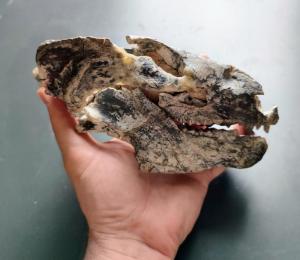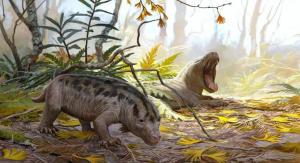The name of the specimem, Paratraversodon franciscaensis, pays homage to the city of Quarta Colônia

The discovery of a new cynodont specimen, a mammalian ancestor animal, in Dona Francisca, in the central region of the state, was published this Monday (29) in the North American journal The Anatomical Record. The study was conducted by a team of researchers lead by the paleontologist Leonardo Kerber, from the Center for Paleontological Research Support of Quarta Colônia (CAPPA) at Universidade Federal de Santa Maria.
The information pertains to a discovery made in 2009 by paleontologists Lúcio Roberto-da-Silva and Sérgio Cabreira in the municipality of Dona Francisca. In the location, within layers of sedimentary rock formed during the Triassic Period, approximately 241-236 million years ago, a complete skull accompanied by a jaw was found. This discovery occurred on the lands of the Bortolin family, in an area that has become crucial for understanding the distant past of the region. The skull belonged to a cynodont, an evolutionary link between reptiles and mammals, which inhabited the region even before the emergence of dinosaurs. Complete specimens from this period are extremely rare, adding significant value to the discovery. However, for several years, the precise identity of this animal remained unknown.
More than a decade after the initial collection, the researchers resumed studying the fossil. The precise identification of the specimen demanded meticulous comparisons with tens of other fossils from Brazilian, German, and British scientific collections. The process involved tomography of the specimen using a high-resolution microtomography scanner, enabling a view of anatomical structures that are not visible externally. The results revealed that the animal exhibited unique features that did not align with any known cynodont specimen.
Paratraversodon franciscaensis

Paying homage to the municipality where it was discovered, the researchers named the new specimen Paratraversodon franciscaensis. This designation not only recognizes the importance of the location but also emphasizes the uniqueness of the discovery.
The animal belonged to the herbivorous Traversodontidae group. The study also revealed that, unlike current mammals, it is possible that it was an ectothermic animal, meaning that it had “cold blood”, similar to the thermal behaviors observed in lizards and crocodiles. During the Triassic period, most creatures had this type of metabolism, as temperatures were significantly higher than they are today. Additionally, the evidence suggests that these animals did not have fur, differing from the typical features of contemporary mammals.
With information and pictures provided by CAPPA









